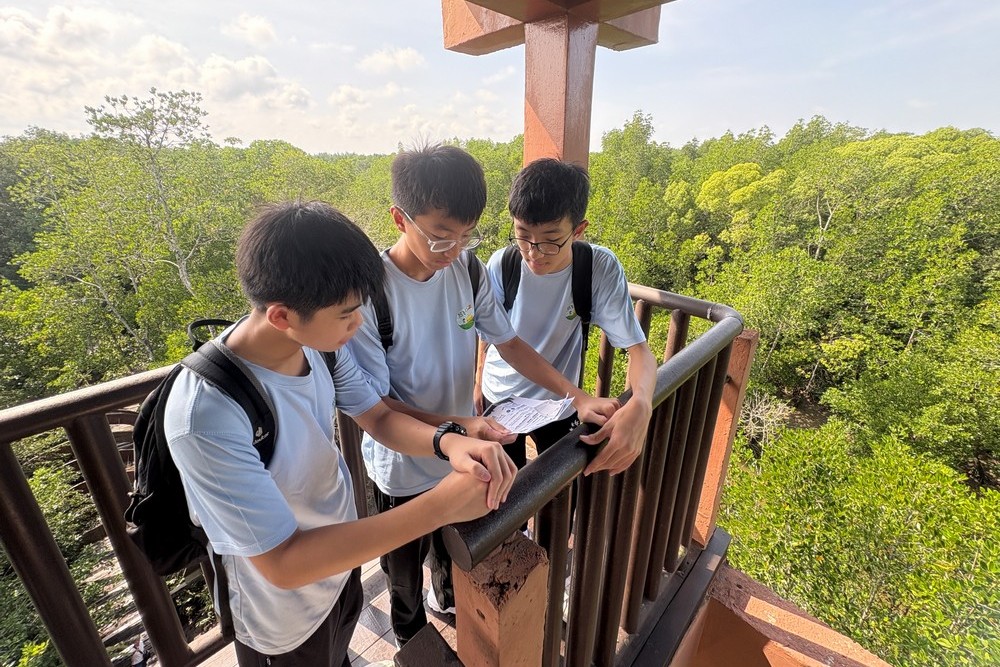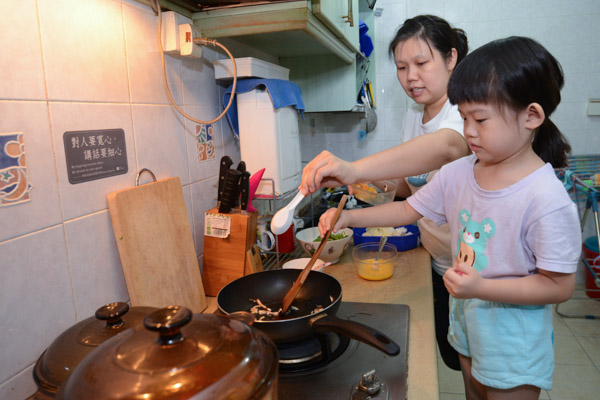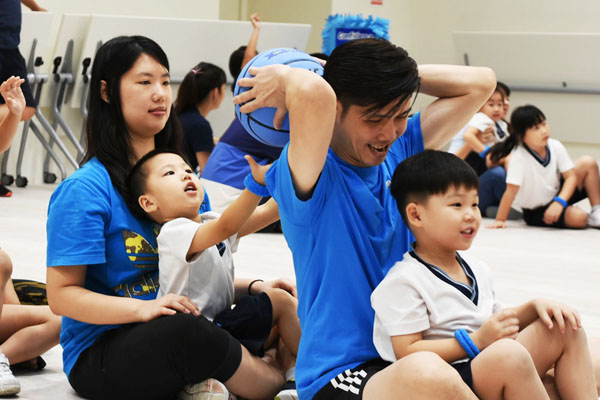
Teacher Chong Voon Hwee explains the concept of the food pyramid to students; meat, sweets and snacks are grouped right at the top of the pyramid because the less we eat them, the better it is for us! (Photo by Chiew Lay Moi)
“Children, do you know what this vegetable is called?”
“It’s a……green vegetable!” “It’s a white-colored vegetable!”
Amidst the chorus of replies, the guide, Shawn Lim smilingly replied: “It’s called ‘Milk Cabbage.’”
On the morning of 17 March 2015, 56 young students from the Tzu Chi Great Love PreSchool together with 9 teachers arrived at a Lim Chu Kang organic vegetable farm for a learning visit. The excitement of the children was palpable as most of them were living in high-rise HDB flats and this was the first time that they were stepping foot in a vegetable farm.
“Teacher, see that farming uncle over there!” “There are beautiful flowers outside!” Strapped safely to their seats in the bus, heads raised eagerly, the children could not stop peering out the windows. Situated in northwestern Singapore, the Koh Fah Technology Farm Pte Ltd (KFTF) is just one of the farms in Lim Chu Kang. That day, the little children also got to experience the KFTF’s Weekend Farm.
Healthy Food is Right in the Vegetable Farm
In conjunction with the teaching topic of “My Healthy Food,” the teachers decided to bring their little charges to the vegetable farm during the school break. At the section where seedlings are cared for, they learnt the process of how the seedlings sprout, are transplanted and finally harvested, a month long endeavour.
Holding a kailan vegetable in his hands, the guide points at the leaves, stem and roots in turn and asked the children to name the various parts. Some of the children had an impressive knowledge in this area; apart from correctly naming each part, they could even state the function of it such as: producing food for the plant, transporting nutrients, and absorbing water.
As the children had only seen pictures of the different vegetables prior to their excursion, they rushed to touch and smell the actual vegetable that was now right before their eyes. Teacher Chong Voon Hwee took the opportunity to inculcate some order and manners in her young charges, telling them to pass the vegetable gently from one child to the other or risk “injuring” it. This was so effective that the children immediately stopped being impatient and even lined up in an orderly manner to await their turn. This impressed Shawn who commented that among the many pre-school visitors he has seen, they were one of the better behaved ones.
Nurturing Plants With Care
After the farm excursion, the little children would embark on their mission— they had to plant and care for the wheatgrass and pea shoot seeds which they had brought back to their school.
The following day, upon reaching the school, they eagerly peered at the seeds which they had soaked in water for the whole night. Seeing that their seeds had sprouted, they hurried to report to the teacher: “Something has already grown out from the seed!” In response, they were told that the process was known as “sprouting.”
The preschoolers had full responsibility for the plants. Whether it was loosening the soil, planting the seed or watering their seedlings, their teacher would only give timely help from the sidelines. When the soil was piled too high, or when water overflowed during watering, they had to learn how to solve these problems and be accountable for their seedlings’ growth. Chong commented that they tended to their plants with love; in moving the seedlings, they lavished as much care as they would a small animal.
Happy Little Farmers
On the third day, the little children noticed that their seeds had grown small green shoots, and they dutifully recorded their observations into their experiential learning notebooks. The teacher too, introduced the concept of the food pyramid to them, explaining that grains, vegetables and fruits should be consumed in bigger amounts while sweets, snacks and meat should best be consumed infrequently.
As their seedlings grew, the children too, felt their gratitude for the earth and its resources increase day by day. Little Phoebe Er Xin Tong shared her opinion, saying “We must finish what’s on our plates because (the act of) planting is not easy, the farmers will cry if we waste food.”
On the seventh day, the seedlings had grown much taller. The teacher cut off pieces of the wheatgrass and offered it to the children, telling them: “Try it and see if you notice a fruity taste.” There were varying responses to this—as they chewed the plant, some remarked that it reminded them of pears, others likened it to sweets, and there were even those who wrinkled up their faces at the taste. Phoebe enjoyed the entire process of planting her wheatgrass; even the taste appealed to her as she liked its sweet flavour.
Waste Not, Want Not
Seeing the changes in the eating habits of her little students, Chong was reminded of how some of them would not even touch a morsel of vegetable when they first stepped into the PreSchool a year ago. Some would even spit out bits of vegetable in their refusal to eat it. To persuade them otherwise, the teachers would try all means and Chong shares that this includes pointing out how other classmates of theirs were consuming vegetables as well as explaining that wasting the vegetables was akin to throwing away one’s blessings.
With the frequent cajoling and advice from teachers, today the students would all empty their plates willingly. According to Chong, even if bits of food fell off their plates onto the table, they would even pick them up and eat them.
Another week later, and it was harvest time! Yet, what the “little farmers” brought home with them was not just the fruits of their labour. After one year of lessons at the Tzu Chi Great Love PreSchool, and the experience of nurturing seedlings with their own hands, it was heartening to note that they had all realized the importance of not wasting food and knew the benefits of consuming vegetables.

Vegetable farm guide Shawn Lim (left) introduces an Amaranth to the children who eagerly reach forward to touch it. (Photo by Chen You Qun)

At the section where seedlings are nurtured, the children learn about the month-long process of how vegetables sprout, are transplanted and finally harvested. (Photo by Chen You Qun)

Through their sense of touch and smell, the little children learn about vegetables. (Photo by Chen You Qun)

At the Weekend Farm, the guide peels apart a piece of aloe vera plant and allows the children to experience the feel of the it on their skin, and thus learn about its healing benefits. (Photo by Chen You Qun)

Before the pupils actually plant their seeds, the teacher explains to them how a plant grows. (Photo by Chua Poh Ling)

Ng Jing Lin (left ) shares that she thinks vegetables look beautiful, and is very focused on the task of nurturing her seedlings. (Photo by Chua Poh Ling)



